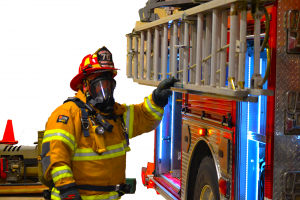“Approximately 73 percent of fire departments go without a program to maintain basic firefighter fitness and health.”
Every fire chief wants to comply with NFPA 1582.
However, it’s not cheap to fulfill the standard’s requirements.
As upkeep costs continue to rise and community donations dwindle, fire chiefs nationwide are looking for ways to limit costs simply to keep their departments operational.
Approximately 73 percent of fire departments go without a program to maintain basic firefighter health and fitness.
That’s concerning, as more than half of all firefighter deaths result from underlying health issues triggered by rigorous physical demands and hazardous work environments.
Research suggests that for every line-of-duty death, there are 17 non-fatal cardiac events that occur on duty.
Eventually, those non-fatal occurrences turn into sudden cardiac deaths, which account for 51 percent of all on-duty firefighter fatalities.
Related Article: Breaking Down The Requirements for NFPA 1582
If money is the issue, then rest assured that solutions exist.
Option 1: Apply for Federal Grants
When you’re struggling to keep your lights on, it feels as if all hope is lost. In low population areas — 2,500 or less — demographic shifts drastically affect volunteer fire departments.
As income decreases, so too does tax revenue.
According to FEMA, those tax dollars account for an average of 65 percent of fire department revenue. Another 17 percent comes from community fundraising.
However, lower income leads to financial hardship, and thus, little to no donations.
Each year, FEMA’s Assistance to Firefighters Grant Program (AFG) awards funding to fire departments in need of financial aid.
In 2018 alone, AFG approved an appropriation of $690 million – $345 million into SAFER grants, and $345 million into Fire and EMS Operations and Safety Grants, Firefighting and Emergency Vehicle Grants and Fire Prevention and Safety Grants.
By writing a “well-prepared, thoughtfully-planned, and concisely-packaged” grant proposal that details your department’s priorities and needs, you’ll give yourself and your company the best opportunity to obtain federal funding.
Sure, grant writing takes time and effort, but the payoff is worth the exertion.
Option 2: Creative Fundraising
With a population of only 435, Goshen Township, Pa. relies on one very small — 7 to 10 active firefighters— volunteer fire department.
Limited funding and variable costs, such as liability insurance, force the town’s volunteer firefighters to maintain a certain level of creativity in their fundraising efforts.
They host “Dinner for Donation” events and square dances to earn extra revenue.
They’re also opportunistic. Once, they held an impromptu boot drive at a temporary traffic light in the township.
Other fire departments host open houses, bingo games, community carnivals, car shows, and even comedy nights.
If your community falls into the “small town” category, then make sure to promote your events throughout the entire county.
Also, it’s not a bad idea to combine forces with other departments for large-scale events, such as a skills competition or golf tournament.
Explain to the community that you want to keep your firefighters healthy and safe with the donations. It just might increase participation.
Option 3: Mergers
In December 2016, the U.S. Fire Administration and FEMA published Critical Health and Safety Issues in the Volunteer Fire Services.
In it, the authors discussed small fire departments, and the financial issues they face.
“Although the economy has been improving across the U.S., many volunteer fire departments continue to struggle,” the authors wrote.
“NFPA’s national fire service needs assessment surveys consistently show that smaller, volunteer departments have the smallest budgets and the biggest financial challenges.”
How big are those financial challenges?
As recently as 2015, 53 percent of fire departments lacked sufficient self-contained breathing apparatuses (SCBA) to equip all of their on-shift personnel.
Furthermore, 72 percent of departments used personal protective clothing (PPC) aged 10 years or more.
When operational expenses limit the department’s ability to keep its equipment in tact, and its firefighters safe, then it may be time to consider a merger.
Some advantages to combining departments are increased staffing; a lighter workload, which in turn reduces stress and allows more time for training; and consolidated funding.
Be the Change For Firefighter Health and Safety
According to the IAFC, “Chiefs have an obligation to find funding sources and develop creative strategies to ensure the safety of their personnel.”
It’s time to get creative for the sake of your company. Firefighters risk their lives fighting fires. When it comes to their health, there’s no need to play with fire as well.
At Worksite Medical, we help you to develop a plan to comply with NFPA 1582 standards.
And, we make sure to fit the testing around your schedule, and at your team’s convenience.
With weekends available, and mobile medical units at the ready, we can the entire clinic to your department.




